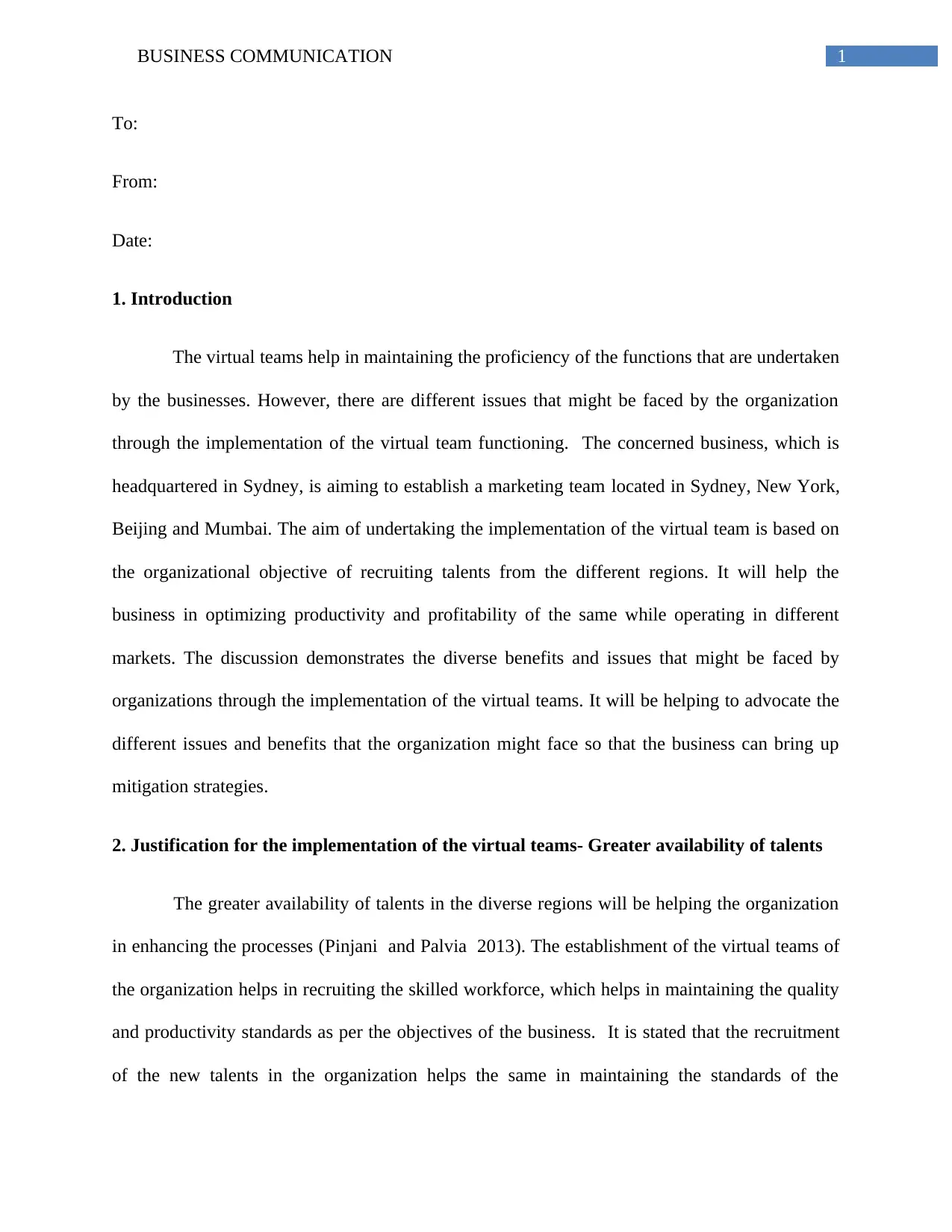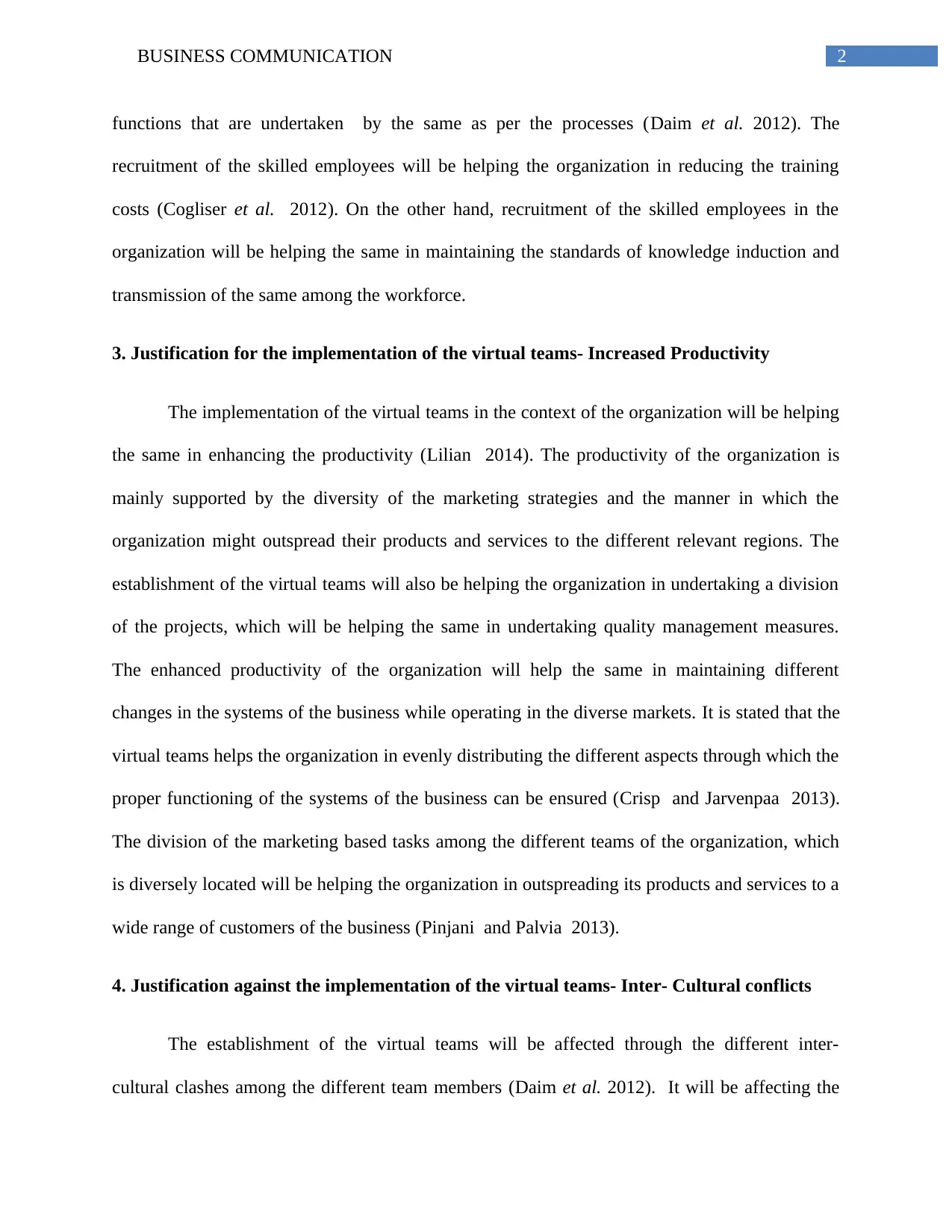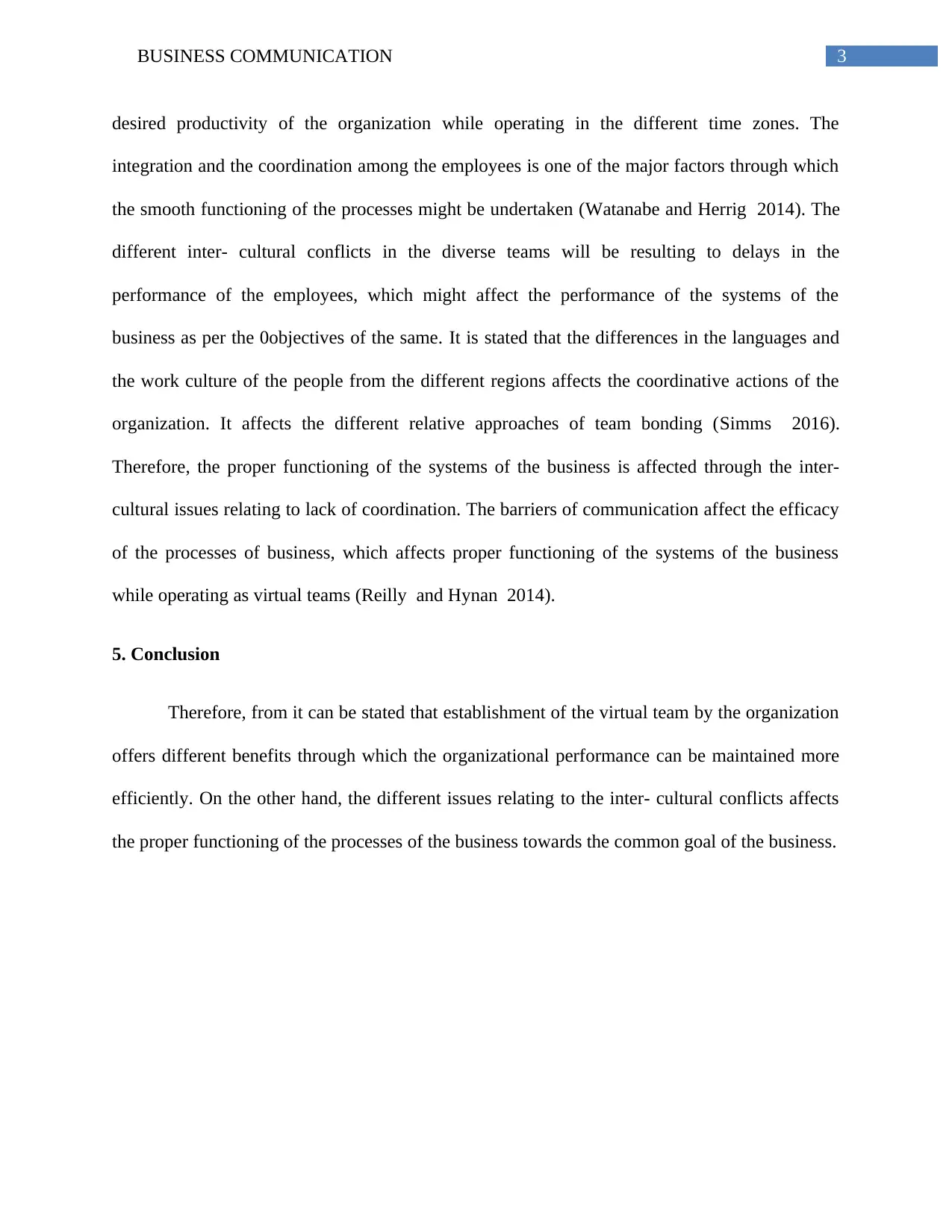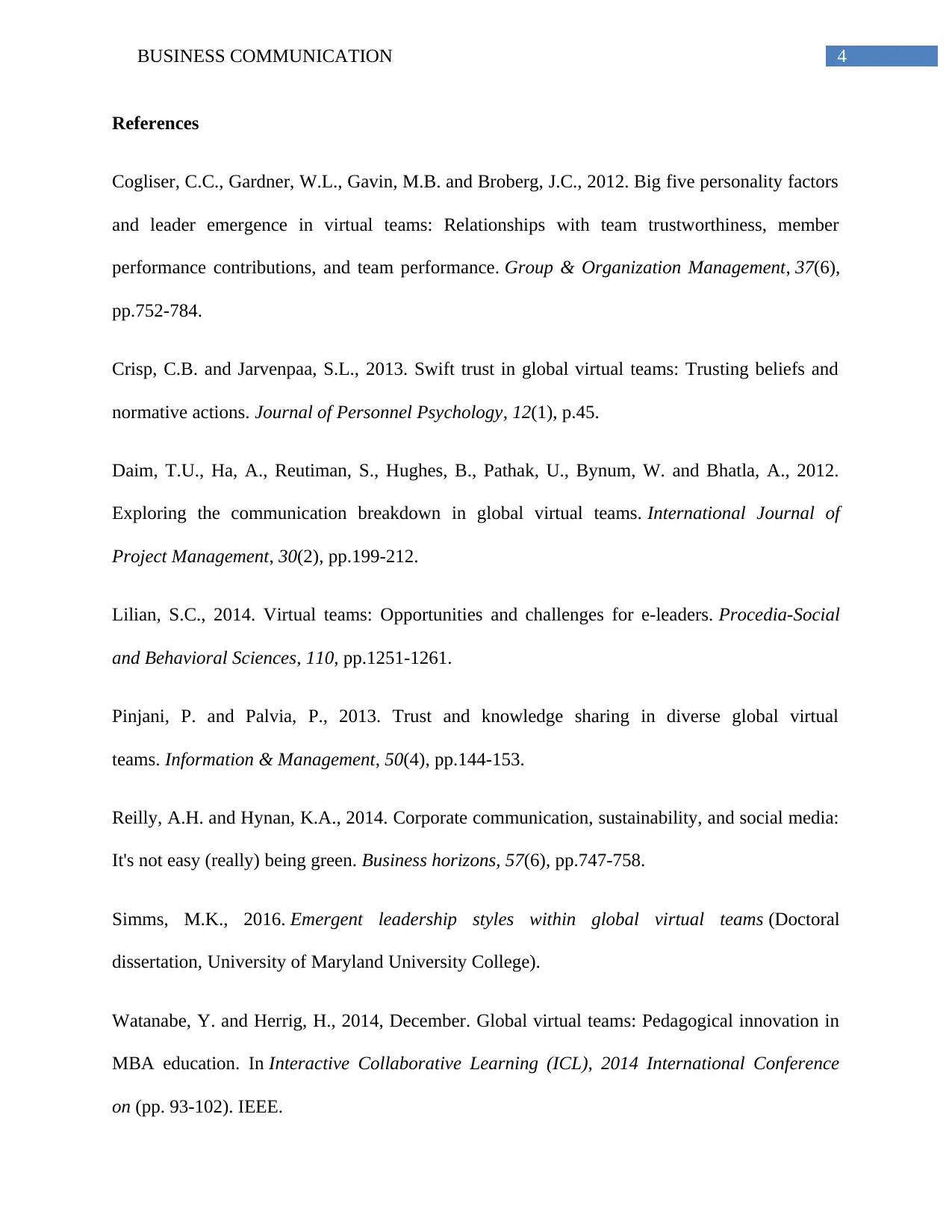Management Communication: Benefits and Issues of Virtual Teams
VerifiedAdded on 2023/06/08
|5
|1181
|417
Report
AI Summary
This report discusses the implementation of virtual teams within an organization headquartered in Sydney, aiming to establish a marketing team across Sydney, New York, Beijing, and Mumbai. The primary goal is to leverage talent from diverse regions to optimize productivity and profitability. The report justifies the implementation of virtual teams by highlighting greater talent availability and increased productivity through diverse marketing strategies and project division. However, it also addresses challenges such as intercultural conflicts that can affect coordination and communication, potentially delaying performance and impacting business systems. The report concludes that while virtual teams offer significant benefits, addressing intercultural issues is crucial for effective functioning and achieving common business goals. Desklib provides access to this document and many other resources for students.

Running head: BUSINESS COMMUNICATION
BUSINESS COMMUNICATION
Name of the student
Name of the university
Author note
BUSINESS COMMUNICATION
Name of the student
Name of the university
Author note
Paraphrase This Document
Need a fresh take? Get an instant paraphrase of this document with our AI Paraphraser

1BUSINESS COMMUNICATION
To:
From:
Date:
1. Introduction
The virtual teams help in maintaining the proficiency of the functions that are undertaken
by the businesses. However, there are different issues that might be faced by the organization
through the implementation of the virtual team functioning. The concerned business, which is
headquartered in Sydney, is aiming to establish a marketing team located in Sydney, New York,
Beijing and Mumbai. The aim of undertaking the implementation of the virtual team is based on
the organizational objective of recruiting talents from the different regions. It will help the
business in optimizing productivity and profitability of the same while operating in different
markets. The discussion demonstrates the diverse benefits and issues that might be faced by
organizations through the implementation of the virtual teams. It will be helping to advocate the
different issues and benefits that the organization might face so that the business can bring up
mitigation strategies.
2. Justification for the implementation of the virtual teams- Greater availability of talents
The greater availability of talents in the diverse regions will be helping the organization
in enhancing the processes (Pinjani and Palvia 2013). The establishment of the virtual teams of
the organization helps in recruiting the skilled workforce, which helps in maintaining the quality
and productivity standards as per the objectives of the business. It is stated that the recruitment
of the new talents in the organization helps the same in maintaining the standards of the
To:
From:
Date:
1. Introduction
The virtual teams help in maintaining the proficiency of the functions that are undertaken
by the businesses. However, there are different issues that might be faced by the organization
through the implementation of the virtual team functioning. The concerned business, which is
headquartered in Sydney, is aiming to establish a marketing team located in Sydney, New York,
Beijing and Mumbai. The aim of undertaking the implementation of the virtual team is based on
the organizational objective of recruiting talents from the different regions. It will help the
business in optimizing productivity and profitability of the same while operating in different
markets. The discussion demonstrates the diverse benefits and issues that might be faced by
organizations through the implementation of the virtual teams. It will be helping to advocate the
different issues and benefits that the organization might face so that the business can bring up
mitigation strategies.
2. Justification for the implementation of the virtual teams- Greater availability of talents
The greater availability of talents in the diverse regions will be helping the organization
in enhancing the processes (Pinjani and Palvia 2013). The establishment of the virtual teams of
the organization helps in recruiting the skilled workforce, which helps in maintaining the quality
and productivity standards as per the objectives of the business. It is stated that the recruitment
of the new talents in the organization helps the same in maintaining the standards of the

2BUSINESS COMMUNICATION
functions that are undertaken by the same as per the processes (Daim et al. 2012). The
recruitment of the skilled employees will be helping the organization in reducing the training
costs (Cogliser et al. 2012). On the other hand, recruitment of the skilled employees in the
organization will be helping the same in maintaining the standards of knowledge induction and
transmission of the same among the workforce.
3. Justification for the implementation of the virtual teams- Increased Productivity
The implementation of the virtual teams in the context of the organization will be helping
the same in enhancing the productivity (Lilian 2014). The productivity of the organization is
mainly supported by the diversity of the marketing strategies and the manner in which the
organization might outspread their products and services to the different relevant regions. The
establishment of the virtual teams will also be helping the organization in undertaking a division
of the projects, which will be helping the same in undertaking quality management measures.
The enhanced productivity of the organization will help the same in maintaining different
changes in the systems of the business while operating in the diverse markets. It is stated that the
virtual teams helps the organization in evenly distributing the different aspects through which the
proper functioning of the systems of the business can be ensured (Crisp and Jarvenpaa 2013).
The division of the marketing based tasks among the different teams of the organization, which
is diversely located will be helping the organization in outspreading its products and services to a
wide range of customers of the business (Pinjani and Palvia 2013).
4. Justification against the implementation of the virtual teams- Inter- Cultural conflicts
The establishment of the virtual teams will be affected through the different inter-
cultural clashes among the different team members (Daim et al. 2012). It will be affecting the
functions that are undertaken by the same as per the processes (Daim et al. 2012). The
recruitment of the skilled employees will be helping the organization in reducing the training
costs (Cogliser et al. 2012). On the other hand, recruitment of the skilled employees in the
organization will be helping the same in maintaining the standards of knowledge induction and
transmission of the same among the workforce.
3. Justification for the implementation of the virtual teams- Increased Productivity
The implementation of the virtual teams in the context of the organization will be helping
the same in enhancing the productivity (Lilian 2014). The productivity of the organization is
mainly supported by the diversity of the marketing strategies and the manner in which the
organization might outspread their products and services to the different relevant regions. The
establishment of the virtual teams will also be helping the organization in undertaking a division
of the projects, which will be helping the same in undertaking quality management measures.
The enhanced productivity of the organization will help the same in maintaining different
changes in the systems of the business while operating in the diverse markets. It is stated that the
virtual teams helps the organization in evenly distributing the different aspects through which the
proper functioning of the systems of the business can be ensured (Crisp and Jarvenpaa 2013).
The division of the marketing based tasks among the different teams of the organization, which
is diversely located will be helping the organization in outspreading its products and services to a
wide range of customers of the business (Pinjani and Palvia 2013).
4. Justification against the implementation of the virtual teams- Inter- Cultural conflicts
The establishment of the virtual teams will be affected through the different inter-
cultural clashes among the different team members (Daim et al. 2012). It will be affecting the
⊘ This is a preview!⊘
Do you want full access?
Subscribe today to unlock all pages.

Trusted by 1+ million students worldwide

3BUSINESS COMMUNICATION
desired productivity of the organization while operating in the different time zones. The
integration and the coordination among the employees is one of the major factors through which
the smooth functioning of the processes might be undertaken (Watanabe and Herrig 2014). The
different inter- cultural conflicts in the diverse teams will be resulting to delays in the
performance of the employees, which might affect the performance of the systems of the
business as per the 0objectives of the same. It is stated that the differences in the languages and
the work culture of the people from the different regions affects the coordinative actions of the
organization. It affects the different relative approaches of team bonding (Simms 2016).
Therefore, the proper functioning of the systems of the business is affected through the inter-
cultural issues relating to lack of coordination. The barriers of communication affect the efficacy
of the processes of business, which affects proper functioning of the systems of the business
while operating as virtual teams (Reilly and Hynan 2014).
5. Conclusion
Therefore, from it can be stated that establishment of the virtual team by the organization
offers different benefits through which the organizational performance can be maintained more
efficiently. On the other hand, the different issues relating to the inter- cultural conflicts affects
the proper functioning of the processes of the business towards the common goal of the business.
desired productivity of the organization while operating in the different time zones. The
integration and the coordination among the employees is one of the major factors through which
the smooth functioning of the processes might be undertaken (Watanabe and Herrig 2014). The
different inter- cultural conflicts in the diverse teams will be resulting to delays in the
performance of the employees, which might affect the performance of the systems of the
business as per the 0objectives of the same. It is stated that the differences in the languages and
the work culture of the people from the different regions affects the coordinative actions of the
organization. It affects the different relative approaches of team bonding (Simms 2016).
Therefore, the proper functioning of the systems of the business is affected through the inter-
cultural issues relating to lack of coordination. The barriers of communication affect the efficacy
of the processes of business, which affects proper functioning of the systems of the business
while operating as virtual teams (Reilly and Hynan 2014).
5. Conclusion
Therefore, from it can be stated that establishment of the virtual team by the organization
offers different benefits through which the organizational performance can be maintained more
efficiently. On the other hand, the different issues relating to the inter- cultural conflicts affects
the proper functioning of the processes of the business towards the common goal of the business.
Paraphrase This Document
Need a fresh take? Get an instant paraphrase of this document with our AI Paraphraser

4BUSINESS COMMUNICATION
References
Cogliser, C.C., Gardner, W.L., Gavin, M.B. and Broberg, J.C., 2012. Big five personality factors
and leader emergence in virtual teams: Relationships with team trustworthiness, member
performance contributions, and team performance. Group & Organization Management, 37(6),
pp.752-784.
Crisp, C.B. and Jarvenpaa, S.L., 2013. Swift trust in global virtual teams: Trusting beliefs and
normative actions. Journal of Personnel Psychology, 12(1), p.45.
Daim, T.U., Ha, A., Reutiman, S., Hughes, B., Pathak, U., Bynum, W. and Bhatla, A., 2012.
Exploring the communication breakdown in global virtual teams. International Journal of
Project Management, 30(2), pp.199-212.
Lilian, S.C., 2014. Virtual teams: Opportunities and challenges for e-leaders. Procedia-Social
and Behavioral Sciences, 110, pp.1251-1261.
Pinjani, P. and Palvia, P., 2013. Trust and knowledge sharing in diverse global virtual
teams. Information & Management, 50(4), pp.144-153.
Reilly, A.H. and Hynan, K.A., 2014. Corporate communication, sustainability, and social media:
It's not easy (really) being green. Business horizons, 57(6), pp.747-758.
Simms, M.K., 2016. Emergent leadership styles within global virtual teams (Doctoral
dissertation, University of Maryland University College).
Watanabe, Y. and Herrig, H., 2014, December. Global virtual teams: Pedagogical innovation in
MBA education. In Interactive Collaborative Learning (ICL), 2014 International Conference
on (pp. 93-102). IEEE.
References
Cogliser, C.C., Gardner, W.L., Gavin, M.B. and Broberg, J.C., 2012. Big five personality factors
and leader emergence in virtual teams: Relationships with team trustworthiness, member
performance contributions, and team performance. Group & Organization Management, 37(6),
pp.752-784.
Crisp, C.B. and Jarvenpaa, S.L., 2013. Swift trust in global virtual teams: Trusting beliefs and
normative actions. Journal of Personnel Psychology, 12(1), p.45.
Daim, T.U., Ha, A., Reutiman, S., Hughes, B., Pathak, U., Bynum, W. and Bhatla, A., 2012.
Exploring the communication breakdown in global virtual teams. International Journal of
Project Management, 30(2), pp.199-212.
Lilian, S.C., 2014. Virtual teams: Opportunities and challenges for e-leaders. Procedia-Social
and Behavioral Sciences, 110, pp.1251-1261.
Pinjani, P. and Palvia, P., 2013. Trust and knowledge sharing in diverse global virtual
teams. Information & Management, 50(4), pp.144-153.
Reilly, A.H. and Hynan, K.A., 2014. Corporate communication, sustainability, and social media:
It's not easy (really) being green. Business horizons, 57(6), pp.747-758.
Simms, M.K., 2016. Emergent leadership styles within global virtual teams (Doctoral
dissertation, University of Maryland University College).
Watanabe, Y. and Herrig, H., 2014, December. Global virtual teams: Pedagogical innovation in
MBA education. In Interactive Collaborative Learning (ICL), 2014 International Conference
on (pp. 93-102). IEEE.
1 out of 5
Related Documents
Your All-in-One AI-Powered Toolkit for Academic Success.
+13062052269
info@desklib.com
Available 24*7 on WhatsApp / Email
![[object Object]](/_next/static/media/star-bottom.7253800d.svg)
Unlock your academic potential
Copyright © 2020–2025 A2Z Services. All Rights Reserved. Developed and managed by ZUCOL.



